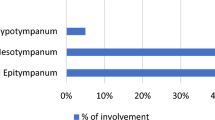Abstract
Objective
The purpose of this study was to evaluate the possibility of attic cholesteatomas concealed within a tiny retraction of the pars flaccida (classification of Tos and Poulsen type I or II attic retraction) in patients with an intact pars tensa of the tympanic membrane.
Methods
The clinical records of patients with a tiny retraction of the pars flaccida and an intact pars tensa of the tympanic membrane who presented to the ear clinic of a tertiary care medical center for the first time between March 2012 and February 2015 were retrospectively reviewed. All patients who had an abnormal pars flaccida of the tympanic membrane were recommended to undergo temporal bone computed tomography (CT) scans. In cases of a soft tissue density lesion within Prussak’s space, an exploratory operation was recommended.
Results
Among 1320 adult patients, 146 patients (n = 168 ears) who had a tiny attic retraction with a normal pars tensa in unilateral or bilateral ears underwent temporal bone CT scans, and 18 ears had a soft tissue density lesion within Prussak’s space. Among the ears with a tiny retraction of the pars flaccida and a normal pars tensa, an attic cholesteatoma was suspected in 10.7% (n = 18 ears) of cases based on the CT scans. After exploratory operations, 2% of patients who underwent CT scans (3 out of 146 patients) and 23% of patients who had a soft tissue density lesion within Prussak’s space on CT scans (3 out of 13 operations) had an attic cholesteatoma.
Conclusion
All attic retractions which are even in cases of Tos type I or II should be examined closely using endoscopy, microscopy, and, if necessary, temporal bone CT scan.


Similar content being viewed by others
References
Sudhoff H, Tos M (2000) Pathogenesis of attic cholesteatoma: clinical and immunohistochemical support for combination of retraction theory and proliferation theory. Am J Otol 21:786–792
Yoon TH, Schachern PA, Paparella MM, Aeppli DM (1990) Pathology and pathogenesis of tympanic membrane retraction. Am J Otolaryngol 11:10–17
Tos M, Poulsen G (1980) Attic retractions following secretory otitis. Acta Otolaryngol 89:479–486
Katehara S, Hozawa K, Futai K, Shinkawa H (2005) Evaluation of attic retraction pockets by microendoscopy. Otol Neurotol 26:834–837
Matsuzawa S, Iino Y, Yamamoto D, Hasegawa M, Hara M, Shinnabe A et al (2017) Attic cholesteatoma with closure of the entrance to pars flaccida retraction pocket. Auris Nasus Larynx 44:766–770
Lee JH, Hong SM, Kim CW, Park YH, Baek SH (2015) Attic cholesteatoma with tiny retraction of pars flaccida. Auris Nasus Larynx 42:107–112
Mills R (2009) Cholesteatoma behind an intact tympanic membrane in adult life: congenital or acquired. J Laryngol Otol 123:488–491
Di Lella F, Bacciu A, Pasanisi E, Ruberto M, D’Angelo G, Vincenti V (2016) Clinical findings and surgical results of middle ear cholesteatoma behind an intact tympanic membrane in adults. Acta Biomed 87:64–69
Sudhoff H, Linthicum FH (2001) Cholesteatoma behind an intact tympanic membrane: histopathologic evidence for a tympanic membrane origin. Otol Neurotol 22:444–446
Tos M (2000) A new pathogenesis of mesotympanic (congenital) cholesteatoma. Laryngoscope 110:1890–1897
Ilica AT, Hidir Y, i N, Satar B, ç I, Arslan HH et al (2012) HASTE diffusion-weighted MRI for the reliable detection of cholesteatoma. Diagn Interv Radiol 18:153–8
Khemani S, Lingam RK, Kalan A, Singh A (2011) The value of non-echo planar HASTE diffusion-weighted MR imaging in the detection, localization and prediction of extent of postoperative cholesteatoma. Clin Otolaryngol 36:306–312
Migirov L, Wolf M, Greenberg G, Eyal A (2013) Non-EPI DW MRI in planning the surgical approach to primary and recurrent cholesteatoma. Otol Neurotol 35:121–125
Author information
Authors and Affiliations
Corresponding author
Ethics declarations
Conflict of interest
The authors declare that they have no conflicts of interest and received no funding concerning this article.
Ethical approval
All procedures performed in studies involving human participants were in accordance with the ethical standards of the institutional and/or national research committee and with the 1964 Helsinki Declaration and its later amendments or comparable ethical standards.
Informed consent
For this type of study with retrospective design, formal consent is not required.
Additional information
Publisher's Note
Springer Nature remains neutral with regard to jurisdictional claims in published maps and institutional affiliations.
Rights and permissions
About this article
Cite this article
Kim, G.W., Jung, H.K., Sung, J.M. et al. A tiny retraction of the pars flaccida may conceal an attic cholesteatoma. Eur Arch Otorhinolaryngol 277, 735–741 (2020). https://doi.org/10.1007/s00405-019-05751-8
Received:
Accepted:
Published:
Issue Date:
DOI: https://doi.org/10.1007/s00405-019-05751-8




